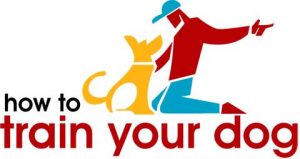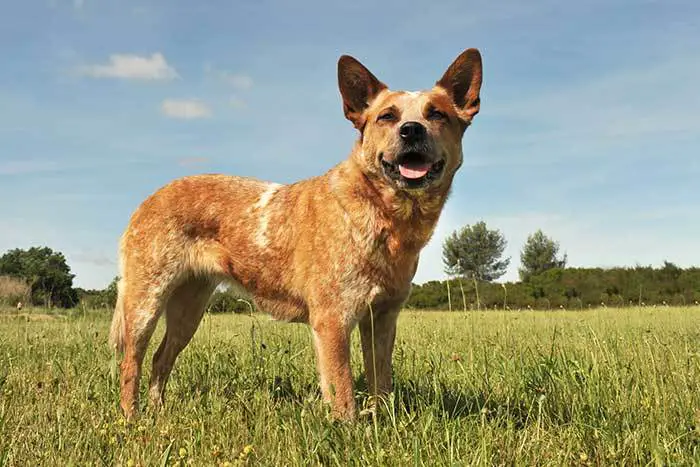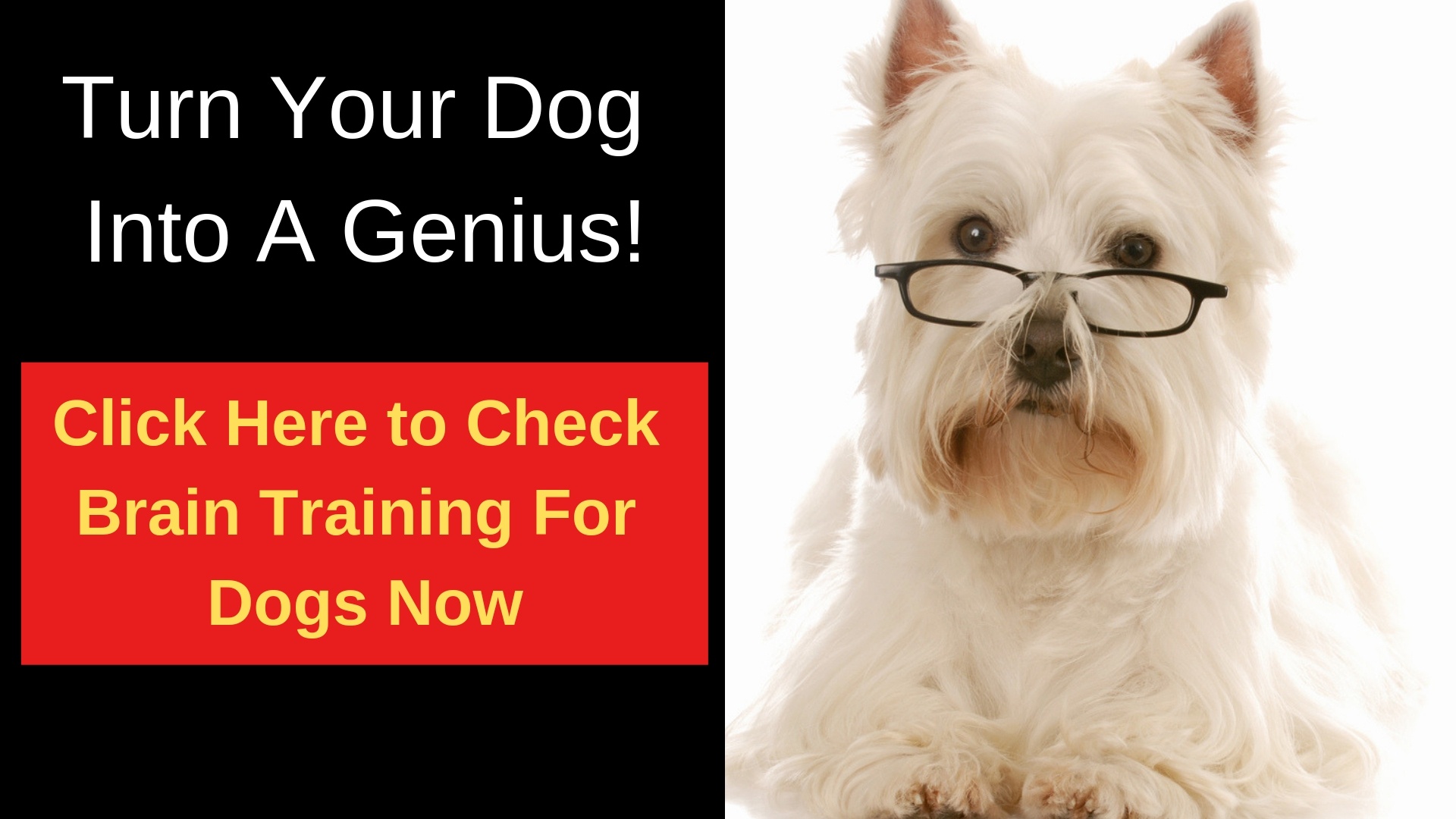More commonly known as the Australian Cattle Dog, the Red Heeler is a lively and energetic dog known for his herding instincts, intelligence and loyalty.
These spirited dogs have been popular among Australian ranches for many years now. They are gregarious and enjoy spending quality time with their masters.
These canines are the perfect blend of intelligence, agility and athletic prowess, all rolled into a cute and compact dog.
But their history as herding animals does not mean they can’t make excellent family companions. These dogs are loyal and protective of their owners and can be very playful and fun-loving companions.
An excellent working dog, the Red Heeler is quite new in the USA, but their popularity is growing at a rapid rate and sits at number 55 among the most popular dog breeds in the world.
So what do you need to know about the Red Heeler? Where did this breed come from? What kind of dog is a Red Heeler?
What does the Red Heeler look like? Do they shed? Are Red Heelers easy to train? What kind of exercise do they require? And where can you find quality Red Heeler puppies for sale?
This comprehensive guide to the Australian Cattle Dog will give you all the answers you need.
So, read on to see images and learn more about the breed… And who knows, you might just find your new best friend!
Table of Contents
The Origin and History of the Red Heeler Dog
Knowing and understanding the history of this breed can help you know what Red Heeler personality traits to expect.
The Red Heeler was originally bred in Australia where they were commonly used to herd cattle – hence the name Australian Cattle Dog.
As their name suggests, Red Heelers would nip the heels of cattle to drive them forward.
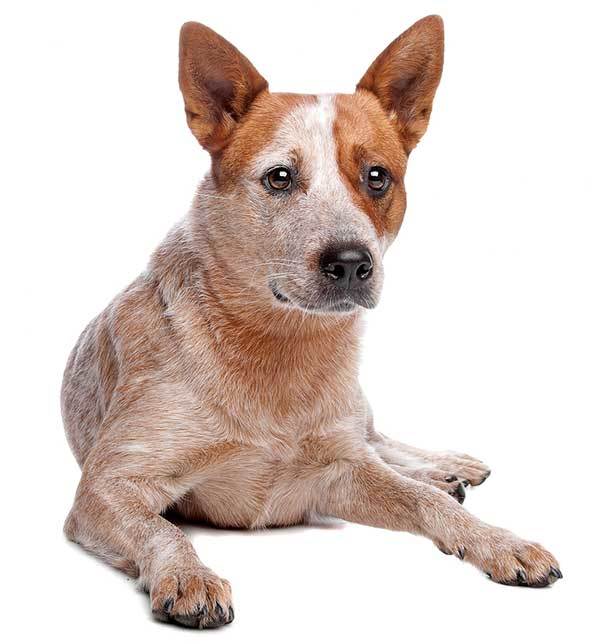
Sometime in the 19th century, George Hall and his family moved from Europe to New South Wales, Australia, where they set up cattle stations.
Soon, he was moving thousands of cattle across tough mountain ranges and bushy areas to the Sydney markets. The main problem was that he was losing many of his cattle along the way.
This prompted George’s son Thomas Hall to bring in drover dogs from Europe to help solve the herding problem. However, the dogs he had imported from England were unable to keep up with the cattle over long distances.
Therefore, the first drover dogs were deemed unfit for this role. They wanted a strong and tough dog who would endure working in the rugged Australian Outback.
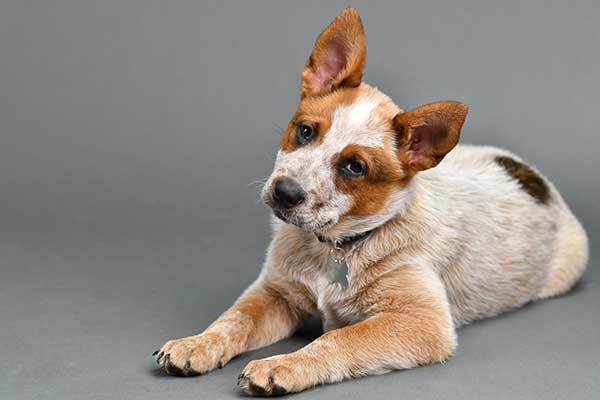
Thomas started crossing these drover dogs with dingoes. Fortunately, the result was a steady cattle dog that soon became known as the Australian Cattle Dog. It is believed that the Heelers were latter crossed with Collies, Dalmatians and Kelpies to produce certain desired traits.
After Thomas Hall’s death in the early 1870’s, the cattle dogs become available outside the Hall family. Robert Kaleski played a major role in the breed’s early development and created the first breed standard for the dogs.
Although the Australian Cattle Dog had been around for quite some time, the dog didn’t start becoming popular until the 1950’s when Sydney-based veterinarian Alan McNiven introduced some dogs to the United States having caused some controversy in his home country.
McNiven had used not only Dingoes and Border Collies, but also Kangaroo Hounds, German Shepherds and Kelpies in his breeding program.
He was found to be “deceitful” in his methods and therefore, the Royal Agricultural Society Club of Australia (RASKC) declined to register his pups as purebred Australian Cattle Dogs.
All of his dogs were also removed from the registry despite his persistent claims that they were true to size, color and temperament.
However, that didn’t stop him. He soon struck a deal with Jack Woolsey, a fellow vet based in Santa Rosa, California. Woolsey took some of McNiven’s dogs with him and developed them back to be acceptable Australian Cattle Dogs, thereby refining the Red Heeler as we know the breed today.
What Are Australian Cattle Dogs Used For?
To this day, Red Heeler dogs are used in the farms to herd sheep and cattle. They also tend to do well in most dog sports.
The Red Heeler is equally adept in the show ring, but some breed purists argue that show dogs are often bred to develop a dog with a shorter leg and a sturdier body structure, and therefore, do not conform to the breed standard.
Today, Red Heelers are commonly used as family pets and companion dogs. These friendly and fun-loving dogs make a great addition to an active family.
Why are Red Heeler Dogs Called So?
The Red Heeler is probably better known by the name Australian Cattle Dog. Other common names for the Australian Cattle Dog include Cattle Dog, Blue Heeler and Queensland Heeler.
All of these names are used to refer to the same breed. Meanwhile, the American Kennel Club (AKC) refers the different variations as the Australian Cattle Dog.
Due to crossing various kinds of dogs, the Australian Cattle Dog came in two major colors: Red and Blue.
Therefore, the Red Heeler and Blue Heeler are obviously named based on the color of the dog.
In other words, there’s no difference between the two except for the color of their fur. However, Queensland Cattle puppies are typically born white, and gradually turn red or blue-gray as they age.
Now that you know the difference between the Red Heeler and the Blue Heeler is all about the coloration, do you know how the name Heeler came to be?
Well, this name dates back from the time when these dogs were used as cattle herders.
The Cattle Dogs would push the lazy and slow-moving cattle to maintain them with the herd by softly nipping at their heels. That was never meant to harm the cattle, but it was simply a way to encourage forward movement.
The Physical Appearance of the Red Heeler
The Australian Cattle Dog is a large, strong and powerful breed. They have muscular legs and a study face.
It is not uncommon for an Australian Cattle Dog to have a “star mark” on his forehead. This mark is known as “Bentley Mark” and was named after a famous dog owned by Tom Bentley.
Red Heelers have small or medium-sized ears that are pricked and set wide apart. These dogs also have a long, straight tail, usually with a dark spot on its tip.
Another major feature that makes it easy to identify a purebred Australian Cattle Dog is their eyes. Their eyes are dark and oval-shaped, with a bright and keen expression.
Coat:
Red Heelers have soft, double coats. As we’ve mentioned above, Australian Cattle Dogs come in a number of different coat colors. That’s why we have the Blue Heeler and the Red Heeler. Both variations are Australian Cattle Dogs.
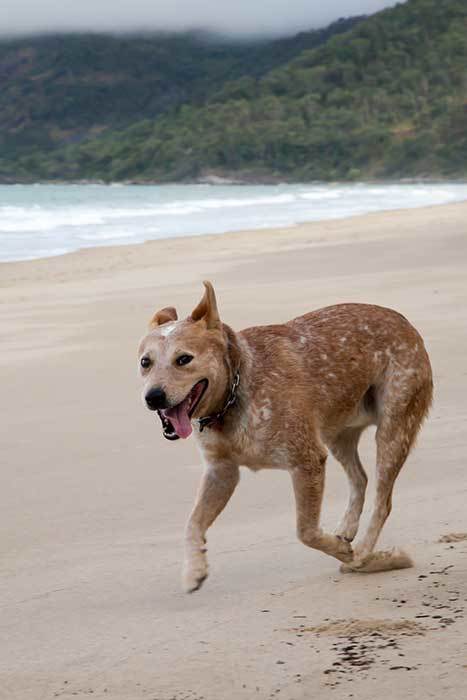
According to the official breed standard, the full color range includes red speckled, red mottled, blue, blue speckled and blue mottled.
Markings can be red, black and tan or simply tan in color.
Other unofficial coat colors can include purple, lavender, chocolate, apricot, silver, and cream in solid, mottled or specked patterns.
👉 One interesting fact about the Red Heeler dog is that puppies are typically born white, and gradually turn red or blue-gray as they age.
This genetic trait can be traced back to their early parents, the Dalmatian. This dog normally has color patches on his body and face. The most common marks are patches on the eyes.
ALSO READ: The Ultimate Guide To The Tamaskan Dog
How Big Will a Red Heeler Puppy Get?
When it comes to size, male Red Heelers will stand around 17 to 20 inches tall. The average male Red Heeler weight is anywhere between 35 and 45 pounds.
Female Red Heelers are 17 to 19 inches tall and weigh around 30 to 62 pounds.
Females have a smaller bone structure and relatively more refined features than their male counterparts. Despite being smaller, however, females are just as talented and hardworking as males.
At What Age Is a Red Heeler Full Grown?
Generally, Red Heelers attain their full height sooner that they achieve their maximum weight. Typically, most Red Heelers are as tall as they will ever be by age 9 to 11 months.
On the other hand, Red Heelers might not achieve their maximum weight until around 18 to 24 months of age.
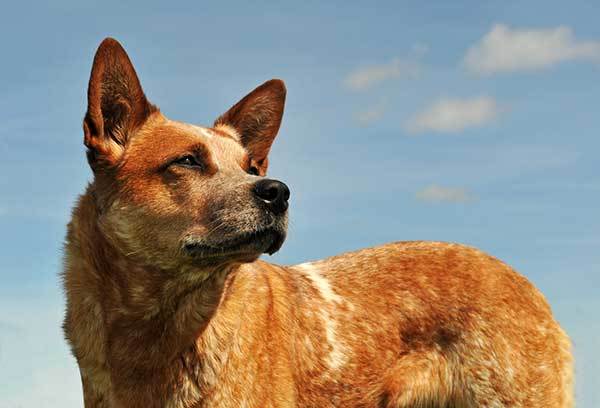
Size as an Advantage:
The size of the Red Heeler dog makes him a great livestock droving dog.
A drover dog pushes cattle forward and ensures they move in the right direction. Nonetheless, livestock are sometimes stubborn and they can kick. Fortunately, the kicks usually fly over the Heeler’s head, saving the dog from any harm.
The Heeler’s size also gives the dog an advantage in agility competitions, allowing the canine to clear hurdles and go through tunnels that would otherwise be difficult for larger and taller canines.
Let’s now take a look at the Red Heeler personality traits.
Red Heeler Temperament
Red Heelers are known for their high-energy levels, and their intelligence, which they developed as they were used as working dogs.
These dogs are also independent, but they need companionship as well. They are also known to be loyal and devoted family companions. They are affectionate dogs who enjoy being around their owner and family.
Heelers also tend to be playful in nature, so they will make great companions and playmates for children. They are almost tireless, so they will keep up with people of all ages.
Australian Cattle Dogs are also very protective and typically form strong bonds with family members they spend time with. As such, you might find your pup defending you against perceived threats even when you have not given him any commands.
While they are friendly towards their family and people they are used to, Heelers are normally reserved around strangers – but that can also turn into suspiciousness if they are not properly socialized from a young age.
How Smart Are Red Heelers?
It is known that the Australian Cattle Dog is one of the smartest dog breeds around. It is their ability to herd cattle and memorize their names that makes them so clever.
The same applies for the Red Heeler dog. They will always surprise you with their level of intelligence and the amount of information they are able to remember.
Since they are both intelligent and independent, they can also be stubborn or difficult to train. Keep reading to learn how to successfully train your Red Heeler puppy.
View this post on Instagram
Are Red Heelers Aggressive?
Among the laidback breeds, Red Heelers don’t really have the best reputation, but they aren’t very aggressive either.
They might be more difficult to deal with when compared to your ordinary easygoing dog. This is because of their dominant genes and temperament.
This breed was developed by crossing domesticated dingoes with other dogs, so your pup might have a bit of a wild and independent side to his personality.
Since Australian Cattle Dogs have some predatory instincts that were not utilized in the cattle herding business, humans embraced it and now use it in their herding activities.
However, Red Heelers are known to be protective of the territory and even attack the strangers they consider a threat.
For that reason, it is extremely important to start socializing your Heeler puppy as soon as you bring him home in order to prevent any form of aggression.
View this post on Instagram
Do Red Heeler Dogs Bark A Lot?
Red Heelers generally do not make a lot of noise while they are working in the fields, but they are sometimes quick to alert their owners if they sense a threat to the family. And you’ll certainly remember their distinctive, high-pitched bark.
These dogs may bark to get your attention, to sound the alarm or when trying to alert you of a potential threat. This habit, combined with the breed’s inherent protectiveness can make the Red Heeler a good guard dog.
ALSO READ: 5 Simple Ways to Stop Your Dog from Barking
Behavior with Strangers
Although Red Heelers can be reserved around strangers, they can also be wary of them if they are not properly socialized.
You should introduce your Red Heeler puppy to friendly people to help him learn to recognize their behaviors. That way, they will be able to spot the difference when they see someone acting strangely.
Without proper socialization, Red Heelers can be suspicious of unfamiliar people, which can be difficult to deal with later on.
Are Red Heelers Good With Children?
Australian Cattle Dogs were bred to perform a specific task: guarding and herding livestock.
For that reason, the Red Heeler is sometimes said to be nippy or mouthy. Nipping comes in handy when herding livestock. However, it is not well-received when a family dog is trying to nip at the heels of adults or children.

Red Heelers also have herding behavior in the house and will sometimes nip or bite during play. This behavior can be unpleasant for children and adults alike.
While the Red Heeler can be a good family dog, he will do best with young children if he has been raised with them and considers them to be members of his family from a young age.
In such cases, Heelers are very friendly and playful. However, the breed’s tendency to be nippy and mouthy can be an issue for smaller kids.
Are Red Heeler Good With Other Dogs?
As a herding breed, Australian Cattle Dogs are intelligent and have natural predatory instincts. This makes them prone to animal aggression.
👉 Many Red Heelers are dominant and aggressive towards other canines of the same sex.
As natural herders, Heelers will try to herd cats and other animals. They tend to be dominant or aggressive towards other canines in herding attempts. However, early socialization can help prevent this.
Again, Red Heelers will nip the animals they are trying to herd due to their natural instinct. Therefore, Red Heelers might not be the best choice for families with cats unless they have been raised together from puppyhood.
View this post on Instagram
Are Red Heelers Good Family Pets?
Red Heelers are high-energy, active dogs that need proper exercises and activities to remain happy and healthy.
Being originally bred to guard and herd cattle, these dogs herding abilities might give you the impression that they are not affectionate. While they are not too cuddly or the needy kind of dog, they will surely be happy when treated well.
They are also independent and sometimes want to be alone. However, they are great guard dogs who should be very loyal and protective of your family.
With proper care, training and socialization, your Red Heeler puppy has the potential to grow and mature into an excellent family pet and companion.
Potential Red Heeler Behavior Problems
The Red Cattle Dog may find it difficult to adapt to an environment where he is exposed to numerous strange dogs.
He might try to be dominant and establish himself as the pack leader, leading to aggression. Early socialization can help prevent this tendency in your Red Heeler.
Obviously, these dogs have a strong nipping insistent, too. This breed herds cattle by nipping at their heels to encourage forward movement.
View this post on Instagram
You may also find your pup chasing after running children trying to herd them.
Bite inhibition can help in preventing these problems in your Red Heeler. You may also want to teach your children to avoid running when your Heeler is around.
Caring For Your Red Heeler
All dogs, regardless of breed, need to be on a proper maintenance schedule. They need feeding, training, exercises, grooming, and veterinary care.
A pup that is loved and taken proper care of will be happy to look after you.
Dogs that are treated badly can react badly to the owner and/or other people. So look after your puppy and he will definitely love you unconditionally and remain a loyal partner to you no matter what.
Here’s what you need to know about taking proper care of your new Red Heeler puppy.
Red Heeler Training
Being a reliable family pet is different from the working dog history of the Australian Cattle Dog. However, proper training can help your dog to flourish in a home environment.
The Australian Cattle Dog is a very smart canine. In fact, this breed ranks as the 10th most intelligent dog breeds in the world.
While the Australian cattle dog doesn’t make the top 50 in popularity rankings, you will definitely agree that this breed is truly intelligent.
Alert, curious and cheerful, these smart dogs need a structured and consistent training program. Make sure the training routine is interesting and fun to keep your puppy engrossed.
Use lots of positive reinforcement so your pup can learn to associate obeying your commands with the goodies or rewards. It is best to give him a treat whenever he obeys your commands of “Come”, “Stay”, “Sit”, or “Heel”.
These Red Australian Cattle Dogs require a firm pack leader to guide them, and your pup looks to you all the time for leadership.
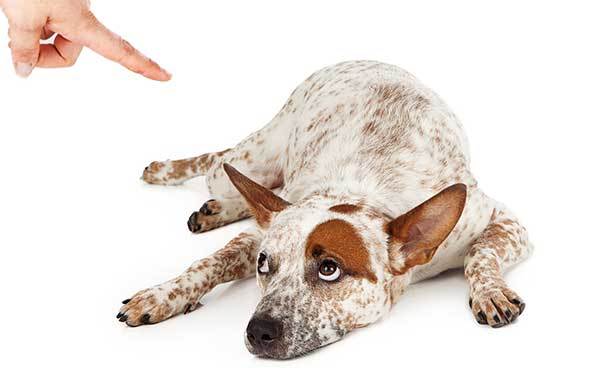
Use hand and verbal commands when training your dog. Be firm and consistent with your commands.
However, yelling or hitting to punish him will only make things worse. Instead, correct bad habits by encouraging good behavior through treats and praise.
On a leash, you can teach your Red Heeler dog various commands. If your pup doesn’t try to nip or herd you, give him plenty of treats and praise.
Red Heelers bond closely with their masters and taking a firm and consistent training approach will help you to achieve faster results. Always be calm and collected in the presence of other people to encourage the same behavior in your dog.
Red Heeler Socialization:
Australian Cattle Dogs are loyal and protective of their owners but they are sometimes wary of strangers and dogs of the same sex.
If Red Heelers are exposed to different people from a young age, they can learn to accept strangers. These canines generally have a high predatory drive, and therefore, they should also be socialized with other pets at an early stage to prevent attacks in the future.
Properly training and socialization can help Heeler puppies to get their natural nipping tendencies under control.
LEARN ABOUT IT: 13 Common Dog Training Mistakes You Ought to Avoid
Exercise Needs
A well-exercised dog is a happy dog. As a working dog, the Red Heeler has high energy levels and needs plenty of exercises to burn off any excess energy.
Therefore, this breed is completely unsuitable for the couch potato lifestyle.
View this post on Instagram
👉 A Labrador Retriever may need just 45 minutes of physical exercise on a daily basis, but a Red Heeler will requires up to two hours of exercise per day.
Some dogs are obviously less active than others, but it’s best to choose a dog breed that will suit your lifestyle, and not just choose the cutest puppy you come across and expect him to match your preferences and lifestyle.
Your Red Heeler’s activity should include long walks, running and jogging. This dog is particularly well suited to jogging and hiking due to their stamina.
Your dog will also do well in a game of fetch, agility training and obedience training. He should also excel in dog sports such as Flyball and Frisbee.
Red Heelers will also enjoy going for a swim, as well, and many of these pups are excellent swimmers.
The high energy of the Red Heeler should be directed towards work or play. Any unspent energy will often manifest itself as destructive behaviors such as chewing your stuff or digging up your home and garden to entertain himself.
View this post on Instagram
Also, provide your Red Heeler with plenty of safe chew toys. Red Heelers tend to use their mouths to explore their immediate environment.
Heeler puppies will mouth on people and chew on your valuable items if they don’t have more acceptable ways to channel their energy and if they have not been taught that mouthing people or chewing on your things is not acceptable.
Train your Red Heeler to play with interactive dog toys to ensure mental stimulation.
If these intelligent dogs do not have a job to do to burn off excess energy, they will find something to do. A properly exercised Red Heeler, both physically and mentally, will be less likely to develop aggressive or destructive behaviors.
LEARN ABOUT IT: 6 Easy Ways to Tire out Your Dog
Red Heeler Shedding and Grooming
Red Heelers don’t shed throughout the year; instead they blow their undercoat twice per year, normally during spring and fall. For that reason, Red Heelers are relatively low-maintenance dogs when it comes to grooming.
Red Heeler dogs have a soft, double coat that is relatively easy to maintain. All you need to do to keep it in tiptop shape is to brush it at least once per week.
However, you may need to brush his coat twice or thrice per week during the shedding season to keep any loose hair under control.
View this post on Instagram
Australian Cattle Dogs don’t have an oil residue in their coat and are therefore, less likely to produce a smell. This means they require only occasional baths. Getting your Red Heeler pup in the tub once a month should be sufficient to keep him clean and smelling good.
Of course, you also need to bathe your pup when he gets particularly dirty as a result of being outdoors throughout the day. If your Heeler is more of an indoors pup, you should consider using deodorizing wipes for dogs to keep him clean in between baths.
To prevent ear infections, you should check your dog’s ears at least once a month. Look out for dirt, parasites, discharge and odor. Wipe your pup’s outer ears with a cotton ball moistened with baby or mineral oil, or a vet-approved ear cleaning solution to help keep them clean.
It is also recommended to trim your Heeler’s nails, as very long nails can make movement painful or uncomfortable for your pet. This can also prevent potential injuries such as foot deformities.
Feeding Information
Red Heeler dogs need high quality dog food that will help increase their stamina and maintain their high-energy levels.
As a working breed, Australian Cattle Dogs require a high-protein diet, so choose kibble formulas containing at least 30–35% protein.
Protein aids in tissue repair and muscle development, and promotes joint strength.
You should also get dog food that has at least 20% fat content to help keep your dog’s energy levels high and keep his coat and skin healthy. Fish oil will provide your dog with sufficient omega-6 and omega-3 fatty acids.
Carbohydrates are also a good source of energy; just make sure to feed your dog digestible carbohydrate-packed foods such as brown rice and sweet potatoes.
View this post on Instagram
So, how much should a Red Heeler eat?
Well, the amount of food you need to give your Red Heeler dog will depend on his age, size, and activity level.
Just like us humans, dogs are individuals, and they don’t enjoy eating the same food every day. However, make sure the food you serve to your dog meets his daily calories requirement.
Full grown Red Heelers need to eat around 1.5 to 2.5 cups of high quality dry dog food each day. Reduce the risk of bloat by splitting this amount into two meals. If you are unsure about the right amount of food to give to your dog, please consult your vet.
LEARN ABOUT IT: The 10 Most Dangerous Human Foods for Dogs
How Long Do Red Heeler Dogs Live?
The average lifespan of the Australian Cattle Dog is around 12 to 16 years. This is slightly more than most dogs in its weight range.
In fact, Bluey, an Australian Cattle Dog, holds the record for the longest living dog in the Guinness Book of World Records. Bluey lived an incredible 29 years and 160 days.
Many Red Heelers are still healthy and active at 12 or even 14 years of age, and it is not strange for them to maintain their sight, hearing and teeth until their last days.
Red Heeler Health Problems
The Australian Cattle Dog is known to suffer from a very rare disease called hereditary polioencephalomyelopathy. This condition affects the central nervous system of a dog, leading to seizures.
As the name shows, this condition is inherited so it can be screened for in both parents. That’s why purebred heritage is vital with this breed.
These dogs can also suffer from a relatively unknown health issue called Osteochondritis Dissecans. This developmental condition is caused by cartilage problems, whereby the joint cartilage is separated from the bone.
This condition commonly affects the shoulder, but can develop in any of the body joints. Milder cases can be managed with proper medication, but severe cases should be corrected surgically.
View this post on Instagram
Hip dysplasia is a rare condition with this breed, but it’s important to test for it in the breeding stock.
Blindness is also uncommon with this breed, but there might be a genetic component, so it is best to screen for progressive retinal atrophy as well.
Is the Red Heeler Right for You?
If you’re on the hunt for a dog who:
• Is medium-sized
• Is robust and well-built
• Has a short coat that comes in attractive colors
• Is intelligent and brave
• Enjoys vigorous exercise and athletic activities
• Makes a excellent watchdog
• Has minimal grooming demands
Then a Red Heeler may be right for you.
While this might not be the right family pet for every family or individual, a well-trained and socialized Red Heeler can make a great companion dog!
View this post on Instagram
Red Heeler Puppies For Sale
Now that you know the physical characteristics, personality traits and care routines of the Red Heeler, do you think this dog is a good match for you?
If so, consider the following points before getting one from a Red Heeler breeder or rescue organization.
Red Heeler Price
So, how much is a Red Heeler puppy? Well, the first thing you need to know is that a Red Heeler puppy costs anywhere between $500 and $2,000+.
You can find licensed breeders not only in Australia, but in the United States too.
Always work with a reputable breeder who can provide you with all the information about temperament, health and other aspects of the puppy.
It is also advisable to ask for personality traits and health issues of both parents. That way, you will be sure you are getting a healthy and well-behaved dog.
View this post on Instagram
Red Heeler Rescue
The Australian Cattle Dog is certainly not the easiest dog breed for the pet dog lifestyle.
For some families and individuals, this highly intelligent and extremely active dog proves to be too much.
For that reason, a number of rescue groups exist nationally and regionally to help find new loving homes and owners for surrendered dogs.
You can also avoid some behavioral issues by picking an adult dog from a rescue group or animal shelter. With a full grown dog, you can see exactly what you’re getting and lots of adult Heeler dogs have proven to be great family pets.
ALSO READ: The Ultimate Guide to the Kangal Dog
Conclusion
The sturdy, active Red Heeler is a wonderful working dog, known for his loyalty and protective instincts towards his owner and family.
Originally developed to herd cattle, this brave and intelligent pup is happiest with a responsible owner who knows his high energy level and daily exercise requirements.
He is best suited to a large or rural home setting where there’s sufficient space for him to work, play and run around.
Whether you’re considering getting a Red Heeler puppy or simply wanted to learn more about this unique dog, we hope that our guide has been informative and helpful to you and you have found answers to all the questions you had.
